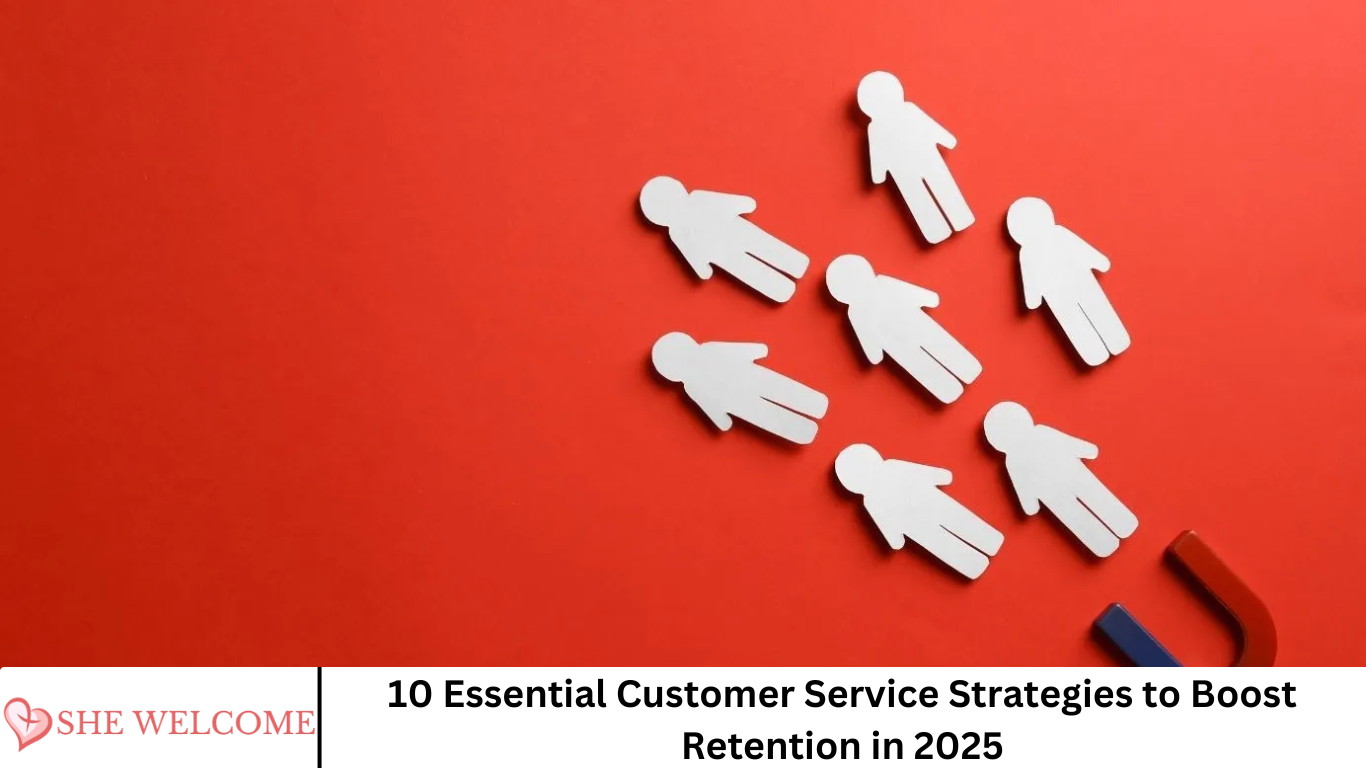Customer retention has become one of the most critical business priorities in 2025. With rising competition and evolving expectations, companies must go beyond transactional service and deliver value-driven, personalized experiences at every touchpoint. Today, exceptional customer service is no longer just a support function—it’s a core differentiator.
We explore 10 essential customer service strategies to boost retention in 2025. These tactics are tailored for B2B companies but are just as impactful for B2C organizations aiming to build stronger customer relationships.
More Read: Smooth Moves: Affordable Ironing for Your Busy Schedule
1. Prioritize Proactive Support
Proactive support involves anticipating customer issues and addressing them before they arise. In 2025, businesses are leveraging predictive analytics and AI to flag potential pain points early. For example, if a customer frequently contacts support about a recurring issue, a proactive outreach with a permanent fix or workaround demonstrates attentiveness and care.
Why it matters: Customers want to feel understood, not just heard. Proactive support builds trust and prevents frustration, reducing the likelihood of churn.
Action Tip: Set up triggers based on customer behavior and product usage data to identify support opportunities before the customer contacts you.
2. Embrace Hyper-Personalization
Generic support responses are a thing of the past. In 2025, successful companies are tailoring interactions to individual preferences, behavior history, and previous touchpoints. AI-driven CRM systems and customer data platforms help support agents deliver hyper-personalized solutions in real-time.
Why it matters: Personalized service shows customers that you value their unique needs and are committed to delivering relevant solutions.
Action Tip: Integrate all customer data into a single view to empower support teams with context-rich insights during every interaction.
3. Leverage Omnichannel Service
Today’s customers expect consistent service across all channels—email, live chat, social media, phone, and even messaging apps like WhatsApp or Slack. Omnichannel support ensures that no matter where a conversation starts, it can seamlessly continue elsewhere without losing context.
Why it matters: A fragmented experience frustrates customers and reduces satisfaction. Omnichannel service creates a unified and convenient journey.
Action Tip: Invest in an integrated support platform that syncs customer interactions across channels and equips agents with full conversation history.
4. Empower and Upskill Support Teams
Your customer service is only as good as the people delivering it. In 2025, companies are investing heavily in agent training, soft skills development, and mental well-being. Empowered agents deliver more empathetic, solution-focused service.
Why it matters: Happy, knowledgeable agents translate to happier, more loyal customers.
Action Tip: Conduct regular training sessions on emotional intelligence, conflict resolution, and new tools. Create a feedback loop to hear directly from agents on what they need.
5. Use AI to Augment, Not Replace, Human Interaction
AI tools like chatbots and virtual assistants are now standard in customer service. However, the most successful companies use AI to enhance, not eliminate, human support. Bots handle routine queries, while complex or emotional issues are escalated to trained agents.
Why it matters: AI improves efficiency, but human empathy and judgment are irreplaceable in building lasting customer relationships.
Action Tip: Implement AI tools with clear escalation paths and regularly audit their performance for tone, accuracy, and effectiveness.
6. Implement a Customer Feedback Loop
Real-time feedback is invaluable for continuously improving customer service. In 2025, smart companies aren’t just collecting feedback—they’re acting on it. Whether through CSAT scores, Net Promoter Scores (NPS), or in-app surveys, insights are analyzed and used to drive improvements.
Why it matters: Listening to customers and making visible changes shows that you value their input and are committed to improvement.
Action Tip: Create a closed-loop system where customer feedback is categorized, addressed, and communicated back to customers.
7. Focus on Customer Onboarding
First impressions matter. An intuitive, value-driven onboarding process ensures customers see success early, reducing early churn. In 2025, onboarding is no longer a one-size-fits-all checklist; it’s customized based on customer roles, goals, and industry.
Why it matters: A strong start sets the tone for a long-lasting relationship and reduces the need for reactive support.
Action Tip: Develop interactive onboarding flows with personalized content, milestone tracking, and dedicated onboarding specialists.
8. Measure and Optimize Customer Effort
How easy is it for your customers to get help or find information? Reducing customer effort is a key strategy in 2025. The Customer Effort Score (CES) is a valuable metric to track and improve.
Why it matters: The easier it is for customers to do business with you, the more likely they are to stay.
Action Tip: Audit your support processes for friction points. Simplify forms, reduce steps in resolution workflows, and provide self-service options.
9. Build a Culture of Customer Centricity
Retention doesn’t just depend on the support team. It requires an organization-wide commitment to customer success. In 2025, top-performing companies bake customer-centric thinking into every department—from product to marketing to finance.
Why it matters: A unified focus on the customer ensures consistent value delivery and aligns teams around shared goals.
Action Tip: Include customer service KPIs in company-wide OKRs and recognize teams that go above and beyond for customers.
10. Deliver Value Beyond the Product
In today’s competitive landscape, your product alone isn’t enough. Companies that drive retention in 2025 offer ongoing education, insights, and community that help customers get more from their investment.
Why it matters: When you become a trusted partner, not just a vendor, customers are more likely to stay and grow with you.
Action Tip: Launch customer education programs, offer thought leadership content, and create peer-to-peer communities where customers can connect and share knowledge.
Frequently Asked Question
Why is customer retention more important than acquisition in 2025?
Customer retention is more cost-effective and drives higher lifetime value. In 2025, with rising customer expectations and acquisition costs, businesses that focus on keeping existing customers loyal gain a competitive edge, better ROI, and more predictable revenue.
How can AI improve customer service without making it feel robotic?
AI can handle routine queries, offer instant responses, and provide agents with real-time insights. When used thoughtfully—with seamless escalation to human agents—it enhances efficiency while maintaining a human touch in emotionally sensitive or complex scenarios.
What is the difference between multichannel and omnichannel support?
Multichannel means offering support through various platforms (like email, chat, and social media), but each may operate in silos. Omnichannel support ensures a seamless, unified experience across all channels, preserving context as customers move between them.
What are some key metrics to track customer retention success?
Essential metrics include:
- Customer Retention Rate (CRR)
- Customer Lifetime Value (CLV)
- Net Promoter Score (NPS)
- Customer Effort Score (CES)
- First Response Time (FRT)
Tracking these KPIs helps evaluate the effectiveness of your support strategies.
How do I personalize customer service without invading privacy?
Use only consented, relevant data to personalize interactions. Focus on purchase history, support tickets, and preferences while respecting privacy policies and data protection laws like GDPR or CCPA.
What role does employee training play in customer retention?
Well-trained support agents are more confident, empathetic, and effective at resolving issues. In 2025, customer loyalty is often won or lost during human interactions—making ongoing agent training essential.
How does a customer feedback loop improve service quality?
A feedback loop captures customer insights and turns them into actionable improvements. It shows customers their opinions matter, increases trust, and allows companies to refine processes and reduce recurring pain points.
Conclusion
Customer expectations will continue to rise, but so will the opportunities to meet and exceed them. By implementing these 10 essential customer service strategies, companies in 2025 can not only retain more customers but also turn support into a powerful growth engine. Remember: retention isn’t just about solving problems—it’s about building meaningful, value-driven relationships that last. Start with one strategy, optimize, and expand. Your future loyal customers are counting on it.


